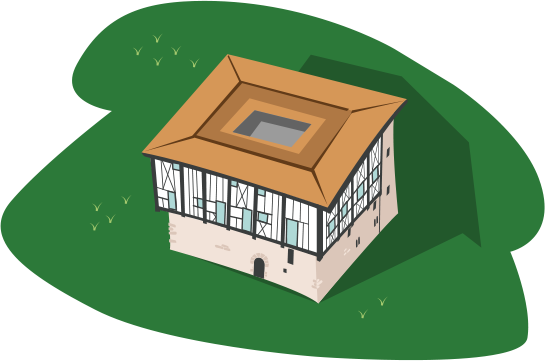
6. IGARTZA: The wooden palace (16th-19th centuries)
Before entering the palace of Igartza we will talk about the coat of arms of María de Igartza.
- The whole structure is made of wood, and the exterior is stone.
- The peasants carried out the cutting and transporting of the wood, while the master carpenters concentrated on designing and carrying out the assembly work.
- We will see an impressive wooden structure built on stone walls
- The carpentry of the structure, the beams, the columns and vaulting give an exotic appearance to the building, which is not common in the Basque Country. It is the largest wooden palace in the Basque Country, the only one with a central courtyard and the only one with a cantilevered gallery.
- It has two loopholes, used for ventilation for the house and animals.
- Initially, it had very small windows, to keep it warm.
- Entrance: A voussoired semicircular arch. Inscription “Hans” in Gothic letters. Later, pointed arches (in the Basque Country they continued to be used until the sixteenth century).
- A hole in the place of the shield (it is believed that it was the same one as in Amezketa, the shield of Maria de Igartza).
- Upper structure:
- Composed of wooden beams and columns, with braces and vaulting of the same material.
- The pieces were counted by means of cuts, they were spread out in the field to facilitate the work, and later they were lifted up by cranes (of that era). In the 15th century, trees 200-300 years old were used in order to obtain the longest beams.
- Roof: Restored using the same techniques (braces, triangular structure). Most of it is original.
- Some beams have decorative carvings (geometric designs etc.).
- In the main room there are paintings dating back 400 years (2 ships, writings, and various faces). María was well known: she taught the teenage daughters of the gentlemen. It is believed that the paintings are related to these classes.
- To build the walls, they used mortar to fill the gaps between the wooden beams, but since the mortar was of poor quality it was necessary to repair them regularly.
- The stairs have not been found.
- There are remains of the kitchen in the window next to the wardrobe. On the outside, ceramic remains have been found. The rubbish was thrown out through the window.
- The ground floor was for the day-to-day activities, the horses and the stable; and on the upper floor were the bedrooms.
